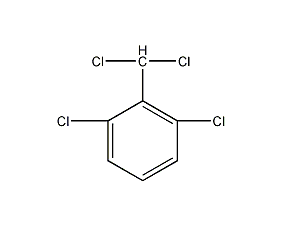
Structural formula
| Business number | 01RW |
|---|---|
| Molecular formula | C7H4Cl4 |
| Molecular weight | 229 |
| label |
None |
Numbering system
CAS number:81-19-6
MDL number:MFCD00016349
EINECS number:201-332-0
RTECS number:None
BRN number:908809
PubChem number:24861778
Physical property data
1. Characteristics: colorless liquid.
2. Density ( g/mL,25/4℃): Unsure
3. Relative vapor density (g/mL,AIR=1): Unsure
4. Melting point (ºC): Unsure
5. Boiling point (ºC,Normal pressure): Unsure
6. Boiling point (ºC,5.2kPa):132-136℃(1.6kPa), 140-142 ℃ (2.13kPa)
7. Refractive index: Uncertain
8. Flash Point (ºC): Unsure
9. Specific optical rotation (º): Unsure
10. Autoignition point or ignition temperature (ºC): Unsure
11. Vapor pressure (kPa,25ºC): Unsure
12. Saturated vapor pressure (kPa,60ºC):�margin-top-alt: auto; mso-margin-bottom-alt: auto” align=left>4. Surface Tension (dyne/cm):42.6
5. Polarizability(10-24cm3):20.08
Compute chemical data
1. Reference value for hydrophobic parameter calculation (XlogP): 4.3
2. Number of hydrogen bond donors: 0
3. Number of hydrogen bond acceptors: 0
4. Number of rotatable chemical bonds: 1
5. Number of tautomers: none
6. Topological molecule polar surface area 0
7. Number of heavy atoms: 11
8. Surface charge: 0
9. Complexity: 116
10. Number of isotope atoms: 0
11. Determine the number of atomic stereocenters: 0
12. Uncertain number of atomic stereocenters: 0
13. Determine the number of chemical bond stereocenters: 0
14. Number of uncertain chemical bond stereocenters: 0
15. Number of covalent bond units: 1
Properties and stability
None yet
Storage method
This product should be stored in a sealed, cool, dark, dry place away from light.
Synthesis method
The preparation method is 2,6-Chlorination of dichlorotoluene yields 2,6-Dichloro–Dichlorobenzyl.
Xianxiang 2,6-Add thionyl chloride to dichlorotoluene, and use phosphorus trichloride as a catalyst , under ultraviolet irradiation at 200℃通 Add chlorine gas, and then use alkali solution to absorb the remaining gas until the mass increases to reach the theoretical amount, and you will get 2, 6- Dichloro– Benzyl dichloride.
Purpose
2,6-Dichloro–Dichlorobenzyl also known as 2,6-二 Chlorobenzylidene dichloride, an important intermediate for the synthesis of benzoyl urea pesticides 2,6-Dichlorobenzaldehyde or 2,6-二 Chlorobenzaldehyde oxime is also an intermediate of the antibiotic diclofenac and penicillin.
AN> 2,6-Add thionyl chloride to dichlorotoluene, and add phosphorus trichloride As a catalyst, under ultraviolet irradiation at 200 ℃, and then use alkali to absorb the remaining gas until the mass increase reaches the theoretical amount, that is, 2,6-Dichloro–Dichlorobenzyl.
Purpose
2,6-Dichloro–Dichlorobenzyl also known as 2,6-二 Chlorobenzylidene dichloride, an important intermediate for the synthesis of benzoyl urea pesticides 2,6-Dichlorobenzaldehyde or 2,6-二 Chlorobenzaldehyde oxime is also an intermediate of the antibiotic diclofenac and penicillin.

 微信扫一扫打赏
微信扫一扫打赏

